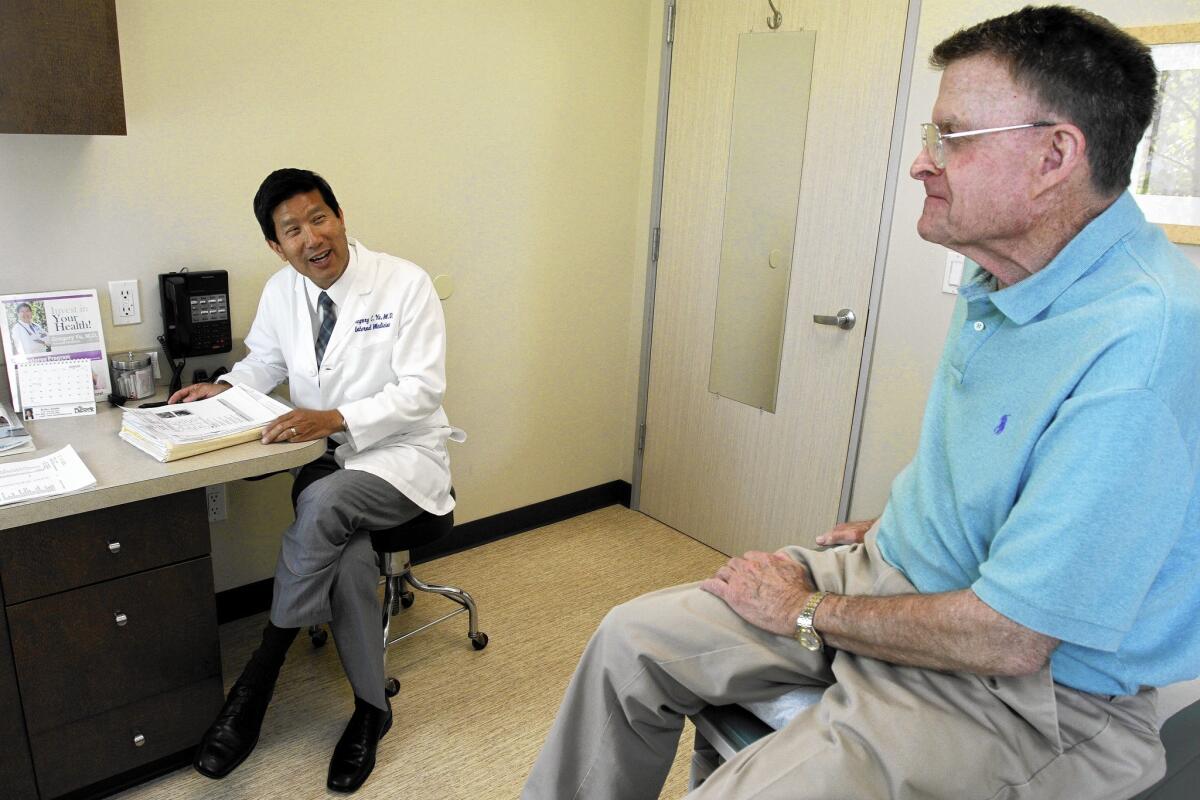Doctors are shifting their business models

With insurance companies often paying doctors less for their services and with paperwork increasing, Dr. Gregory Yu was putting in longer workdays to squeeze in more patients.
He figured there had to be a better way. So a few years ago he shifted a portion of his practice to a concierge model in which patients pay a monthly fee of $150 in exchange for more of his time — both in and out of the office.
“It was more for my own personal longevity,” said the La Cañada Flintridge internist, explaining why he made the switch. “If I have to see patient after patient after patient, and I’m not really feeling the satisfaction of doing the best job that I possibly could for people, I was afraid I might burn out.”
Being a doctor in private practice today is more complicated than it used to be, with growing financial pressures, more government regulation, greater oversight by insurers, rapid developments in medicine and pressure to keep up with technology.
“Practices are being asked to do more with less,” says Dr. Susan Turney, chief executive of the Medical Group Management Assn., which represents professionals running medical practices.
In response, doctors say they are increasingly looking for new ways to practice medicine so they can spend more time with patients and less time on paperwork — while maximizing their incomes.
Many are giving up on independent practice to become employees of larger healthcare systems, Turney says.
In fact, a national survey of 13,500 doctors by the Physicians Foundation, a nonprofit organization representing the interests of physicians, shows that in 2000 more than half were practicing independently. But by 2013, that share had shrunk to a third.
In some cases, those wanting to remain independent are switching to alternate models, such as the concierge-style practice that Yu adopted. For consumers, that can mean changes in the way they get their medical care and how they pay for it.
Experts outline a few common ways doctors are shifting the way they do business and how they’re likely to affect your care and your wallet.
Large group and hospital-affiliated practices: Physician group practices of all kinds are not new; neither is being employed by a hospital or other healthcare organization, such as Kaiser Permanente.
But in recent years the Affordable Care Act and other market forces have been pushing doctors to work together more closely with the overall goal of improving the quality and cost-effectiveness of care.
Many independent doctor practices — and even group practices — are being purchased by hospitals and insurance companies, as more doctors today wish to be employed rather than running their own practice.
On the upside, these models push for more of a team-based approach to care. They also may offer quicker access to specialists, and — for physicians — more time for families and outside interests.
For patients, it often means your information is shared among your providers via electronic medical records, so everyone caring for you knows about your medical history and the treatment you’ve received.
If your doctor’s office is newly part of a hospital system, you may see your costs climb. That’s because hospitals typically charge more for the same service provided in a doctor’s office.
For example, Turney says, “You can get your chest X-ray done at the clinic and it’s going to cost you $400, but if you get it done in the hospital it’s going to cost you $800. The procedure itself still costs $400. It’s just that you had an additional charge for the facility.”
Concierge medicine: There are several models today in which physicians like Yu collect a retainer fee directly from patients, instead of relying entirely on insurance company reimbursements.
These practices ask patients to pay an annual fee that can range from $1,200 to $10,000. Services can include access to same-day appointments, more time during office visits and around-the-clock contact with physicians via phone, email and text.
Some newer models are referred to as “direct pay” practices. These may provide unlimited primary care services for a monthly fee that can range from $50 to $150.
Doctors vary in their approach, but the common goal is to provide patients with a higher level of attention and service. For some people that’s a clear advantage.
“People who are managing complex conditions sometimes need a little more TLC, or they need a little bit more education,” says Wayne Lipton, chief executive with Concierge Choice Physician, a Rockville Centre, N.Y., concierge practice organization.
Just keep in mind that doctors’ attraction to concierge medicine is often to spend more time with patients and less time on the business side of the practice, says Greg Mansur, healthcare principal in the Los Angeles office of consulting firm PricewaterhouseCoopers.
“That burden in these models can shift over to the patient. All of a sudden they’ve got to do what used to be handled by the doctor’s office in filing the claim with the insurance company,” he says.
Cash-only practices. Other physicians frustrated by low insurance reimbursements and challenges collecting fees are choosing not to participate in insurance networks and instead selling services directly to patients.
“It eliminates muddying the water by creating a direct relationship between the patient and the physician,” says Daniel Goldberg, president of Free Market Health Group in Parsippany, N.J.
Yu, the internist, says shifting to concierge medicine allows him to provide better service to his patients and has made him happier at work. “That’s the No. 1 thing. I want to practice for the long term.”
Zamosky is the author of “Healthcare, Insurance, and You: The Savvy Consumer’s Guide.”






